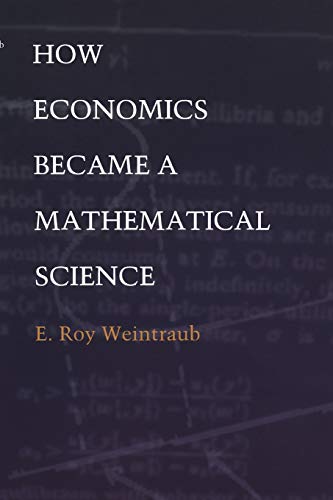How Economics Became a Mathematical Science (Science and Cultural Theory)


sku: COM9780822328711USED
ACCORDING TO OUR RECORDS THIS PRODUCT IS NOT AVAILABLE NOW
$5.73
Shipping from: Canada
Description
In How Economics Became a Mathematical Science E. Roy Weintraub traces the history of economics through the prism of the history of mathematics in the twentieth century. As mathematics has evolved, so has the image of mathematics, explains Weintraub, such as ideas about the standards for accepting proof, the meaning of rigor, and the nature of the mathematical enterprise itself. He also shows how economics itself has been shaped by economists’ changing images of mathematics. Whereas others have viewed economics as autonomous, Weintraub presents a different picture, one in which changes in mathematics—both within the body of knowledge that constitutes mathematics and in how it is thought of as a discipline and as a type of knowledge—have been intertwined with the evolution of economic thought. Weintraub begins his account with Cambridge University, the intellectual birthplace of modern economics, and examines specifically Alfred Marshall and the Mathematical Tripos examinations—tests in mathematics that were required of all who wished to study economics at Cambridge. He proceeds to interrogate the idea of a rigorous mathematical economics through the connections between particular mathematical economists and mathematicians in each of the decades of the first half of the twentieth century, and thus describes how the mathematical issues of formalism and axiomatization have shaped economics. Finally, How Economics Became a Mathematical Science reconstructs the career of the economist Sidney Weintraub, whose relationship to mathematics is viewed through his relationships with his mathematician brother, Hal, and his mathematician-economist son, the book’s author.
Price history chart & currency exchange rate
Customers also viewed

$6.36
JUSTGOLD Texture Rich Lipstick Long-Lasting Semi-Matte Finish - 4 g - Shade 183- Purple
myntra.com
$13.31
BOROSIL Artisan Series Vista Transparent 3 Pieces Glasses Printed Water Bottles 550 ml
myntra.com
$7.62
PERPAA Velvet Kiss Set of 3 Waterproof Matte Liquid Lipstick -3.5 ml Each -Shades 01-02-04, Red
myntra.com
$58.24
Flower Girl Dresses White Tulle Lace Appliques With Bow Half Sleeve For Wedding Birthday First Communion Gowns
aliexpress.com
$7.01
soft cotton baby boy girl romper overall color long sleeve hooded jumpsuit infant toddler clothes
fordeal.com
$8.41
1 ebay hot sale fashion diamond black square diamond ring european and american ring ladies
fordeal.com
$5.35
mengtai galaxy night song masking washi tape decorative gilding bubble adhesive tape decora diy scrapbooking sticker
fordeal.com
$99.50
portable folding wash basin household plastic laundry tub wash vegetable washing folding basins kitchen bath foot fold bucket
fordeal.com
$6.66
Хип-хоп титана сталья улыбаясь лицо ключицы Чокер Пара Личность Подвеска Ins Мода Короткое ожерелье
joom.ru
$21.12
Датчик температуры и влажности RS485, датчик температуры и влажности, DIP-переключатель, модуль датчика влажности и влажности 0-5 в 0-10 в
aliexpress.ru
$21.68
Сумка для кемпинга на открытом воздухе, вместительная утолщенная керосиновая сумка для хранения ламп, ткань Оксфорд 600D, водонепроницаемое ...
aliexpress.ru
$6.88
Квадратные решетчатые набивные L-образные Чехлы для дивана в гостиную, защита для дивана, пылезащитные эластичные растягивающиеся Чехлы дл...
aliexpress.ru
$31.34
Тонер для лица Provamed Sensitive Toner, Тонер для очищения и снятия раздражения чувствительной кожи лица
sifo.ru
$13.18
Wall Clothes Hooks Solid Wood Wall Hooks Household Clothes Shelf Towel Coat Hook Wall Hangers Bathroom Hook Wall Rack Key Holder
aliexpress.com
$924.61
JCHB 2021 High Quality Mens Genuine Leather Sheepskin Jackets Motorcycle Fashion Long Sleeve Zippers Lapel Slim Fit Male Outerwe
aliexpress.com
$19.59
Soared Professional Thicken Ski Snowboard Roller Skating Thicken Knee Protector Brace Pad Black L
aliexpress.com
$9.98
Dominic Fike 3 Nights Metal Signs Club Party Living Room Painting Dcor Customize Tin sign Posters
aliexpress.com
$123.85
2020 new gao bang flowers technical canvas shoes high oblique casual shoes 3m mens women luxury designer shoes 36-44, Black;red
dhgate.com
$21.06
1pc finger resistance bands hand gripper forearm wrist training stretcher exercise pull ring grips expander fitness equipment
dhgate.com












